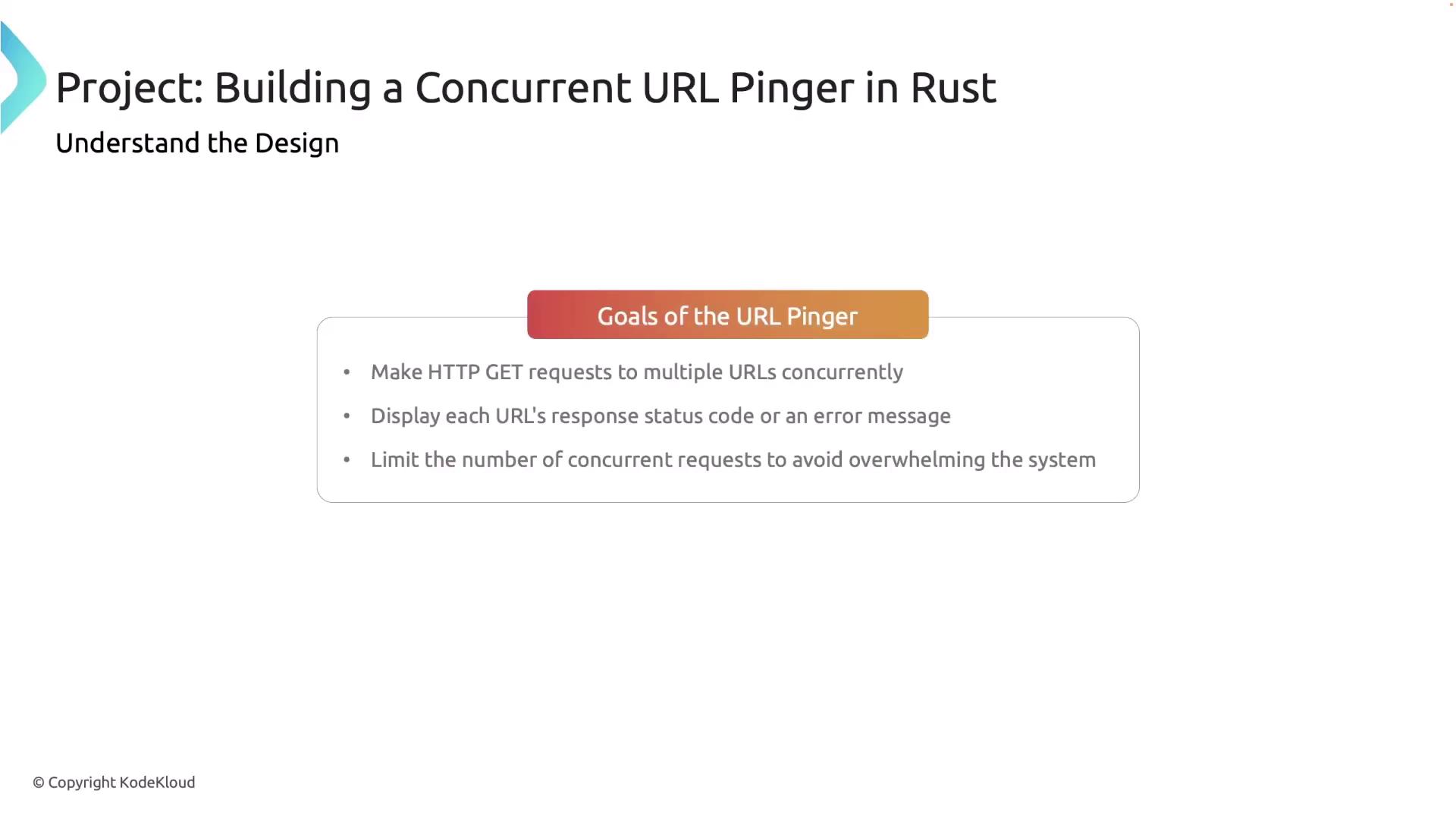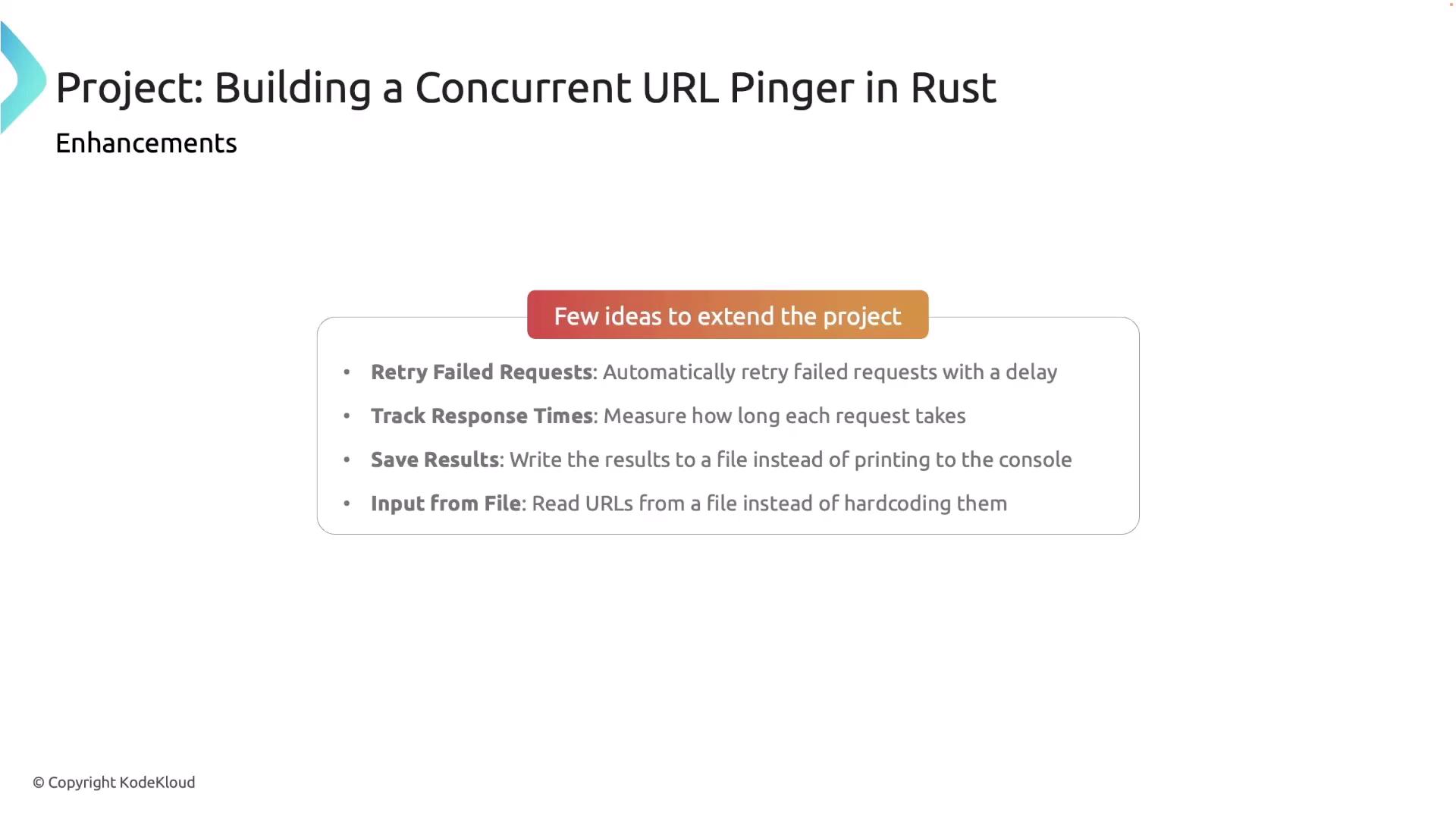Rust Programming
Asynchronous Programming
Building a Concurrent URL Pinger
In this lesson, you'll learn how to build a concurrent URL pinger in Rust. This project showcases asynchronous programming by concurrently pinging multiple URLs and displaying their HTTP status codes using Rust's async features.
Project Goals
The primary objectives for this project are:
- Make HTTP GET requests to several URLs concurrently.
- Display each URL’s response status code or provide an error message if the request fails.
- Limit the number of concurrent requests to prevent overloading the system.

Components Overview
This project leverages the following components:
- HTTP Client: The
reqwestlibrary is used for making HTTP GET requests. - Concurrency: The Tokio runtime's
tokio::spawnfunction enables asynchronous task management. - Error Handling: Errors during HTTP requests are managed gracefully with informative error messages.

Setting Up the Project
Start by creating a new Rust project. Open your project in your favorite editor (e.g., VS Code) and update your Cargo.toml file to include the dependencies for Tokio and reqwest:
[package]
name = "concurrent_url_pinger"
version = "0.1.0"
edition = "2021"
[dependencies]
tokio = { version = "1", features = ["full"] }
reqwest = "0.11"
Implementing the URL Pinger
Below is the full implementation of our URL pinger. This code demonstrates how to perform asynchronous HTTP requests, spawn tasks for each URL, and use a semaphore to limit the number of concurrent requests.
use reqwest::StatusCode;
use reqwest;
use tokio::task;
use tokio::task::JoinHandle;
use std::sync::Arc;
use tokio::sync::{Semaphore, OwnedSemaphorePermit};
async fn ping_url(url: &str) -> Result<StatusCode, reqwest::Error> {
let response = reqwest::get(url).await?;
Ok(response.status())
}
async fn ping_urls(urls: Vec<&str>, max_concurrent: usize) {
let semaphore = Arc::new(Semaphore::new(max_concurrent));
let mut handles: Vec<JoinHandle<()>> = Vec::new();
for &url in &urls {
// Acquire a permit to limit concurrent tasks.
let permit: OwnedSemaphorePermit = semaphore.clone().acquire_owned().await.unwrap();
let url_str = url.to_string();
let handle = task::spawn(async move {
// The permit is automatically released at the end of this async block.
match ping_url(&url_str).await {
Ok(status) => println!("{} -> {}", url_str, status),
Err(err) => println!("{} -> Error: {}", url_str, err),
}
drop(permit); // Explicitly drop the permit when done.
});
handles.push(handle);
}
// Await completion for all spawned tasks.
for handle in handles {
let _ = handle.await;
}
}
#[tokio::main]
async fn main() {
let urls = vec![
"https://www.rust-lang.org",
"https://www.google.com",
"https://www.github.com",
"https://thisurldoesnotexist.xyz",
];
println!("Pinging URLs...");
// Limit the number of concurrent tasks to 5.
ping_urls(urls, 5).await;
println!("Done!");
}
Code Explanation
Dependencies and Imports
The necessary modules are imported to manage HTTP requests usingreqwestand handle asynchronous tasks usingtokio. Concurrency is controlled with a semaphore wrapped in an Arc.ping_urlFunction
This async function sends an HTTP GET request to the given URL and returns its status code. Errors during the request are propagated using the?operator.ping_urlsFunction
This function accepts a list of URLs and a concurrency limit. It creates a semaphore to restrict the number of simultaneous HTTP requests. Each URL is processed within an asynchronous task that waits for a permit before proceeding. Once the request is finished, the permit is released.mainFunction
The entry point of the application, which initializes the Tokio runtime, defines the target URLs (including one invalid URL for error demonstration), and callsping_urlswith a limit of 5 concurrent tasks.
Running the Program
After building the project, run it from the terminal with the following command:
cargo run --quiet
You should see output similar to the following:
Pinging URLs...
https://thisurldoesnotexist.xyz -> Error: error sending request for url (https://thisurldoesnotexist.xyz): error trying to connect: dns error: failed to lookup address information: nodename nor servname provided, or not known
https://www.google.com -> 200 OK
https://www.rust-lang.org -> 200 OK
https://www.github.com -> 200 OK
Done!
This output shows that valid URLs returned HTTP status code 200, while the invalid URL resulted in an appropriate error message.
Ideas for Extending the Project
There are several ways to enhance your concurrent URL pinger project:
- Retry Failed Requests: Implement a mechanism to retry URLs that initially fail.
- Timeouts and Delays: Add configurable timeouts or delays to handle slow responses.
- Response Time Tracking: Measure and log how long each request takes.
- Saving Results: Write the output to a file for later analysis.
- Dynamic URL Input: Allow URLs to be read from an external file or user input instead of being hardcoded.

Conclusion
In this lesson, we covered:
- How to perform asynchronous operations in Rust using
asyncandawait. - How to spawn multiple concurrent tasks with
tokio::spawn. - How to control the level of concurrency with a semaphore to manage simultaneous HTTP requests.

Congratulations on creating a fast and efficient concurrent URL pinger in Rust!
Watch Video
Watch video content
Practice Lab
Practice lab